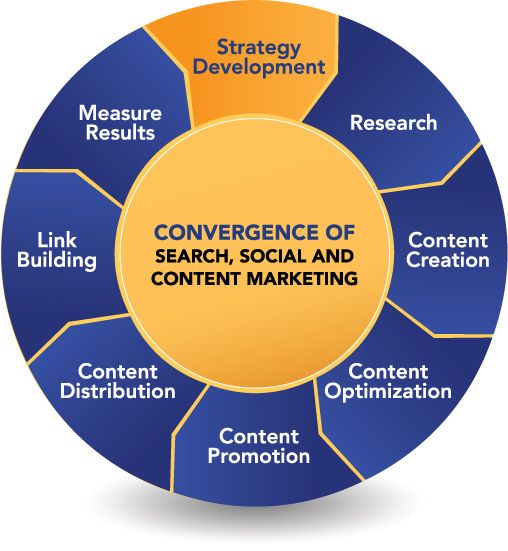
You probably have a website. Has your philosophy for it evolved with the times? Contemporary websites offer more than just information about your company, contact information, and your product offerings. They now provide resources for solving customer problems, can be hubs for social activity, and, most importantly, are rich with fresh and engaging content that is regularly updated so that visitors will frequently return. Content strategy, then, begins with the question: What’s the point of your website?
Many business owners think that the purpose of their website is self-evident, that the questions “Why do you have a website?” and “Why do you produce web content?” are rhetorical ones that don’t need answering. I think just the opposite. Businesses must answer these questions first and foremost.
What Do You Want To Accomplish?
When our clients come to us for help with their content strategy, we ask them right off the bat what they want to accomplish. Sometimes, our clients don’t have the best answer. They tell us things like, “We know that content is king, so we need to add more content.” Or, “Our competitors are putting some really great things on the web so we need to too.” While both answers contain truth, they miss the mark when it comes to the strategy. We tell our clients that the question is actually quite simple, but the answer is not. Organizations should develop a content strategy because:
- Web content provides the customer with clean, logical access to products and services and should funnel them to the site’s conversion pages.
- Web content provides information that answers some of the toughest problems customers face.
- Web content positions the organization as the trusted expert in its industry.
Notice that the purpose of your web content centers on the customer’s experience. Just like keyword research attempts to identify what your customers are searching for in your industry, your website can provide the answer to those searches. A smart content strategy begins with understanding what the customer needs rather than what you want to offer them.

Measurable Objectives
In order for your content to deliver, you need a strategy with specific objectives that guides your content creation. By implementing measurable goals, you will be able to assess the success of your various projects and discover what’s working for you and what’s not. You need to consider the measurable objectives that will drive your content development.
The objectives for your content apply both at the macro level for your whole content enterprise, and at the micro level for each individual piece of content. Your content will be working for you when it:
- Develops and increases your brand awareness
- Generates traffic to your site and garners new customer leads or sales
- Enhances your online reputation
- Encourages natural links and optimizes your search engine rankings
- Increases your competitive advantage
When you produce any single piece of content, it should accomplish one or more of these goals, and the sum total of all your content should accomplish all of them. An investment in a content marketing strategy is largely a matter of time and effort, and you want to be sure that every minute you devote to creating content yields a product that works to your advantage. By basing your content creation on your main objectives, your content development campaign will be much more efficient, maximizing the return on your investment.
Keep your objectives at the forefront of every piece of content that you develop. Before you create new content, hold it up against your objectives and ask:
- Will this content position my company as a thought leader?
- Does it help solve my market’s challenges?
- Will it generate qualified traffic to my site?
- Is this content better or different than what my competitors are offering?
Begin by taking a step back and looking at your overall content portfolio. Determine if you’ve created content that fulfills these objectives in one way or another. Are there any holes? Have you neglected any particular objective? For example, has it been a while since you’ve tended to your product pages?
Your objectives will guide you, not only as you create new content but also as you evaluate the current content you have. It’s critical that each piece of content works toward your objectives. Let’s go through each one of the objectives in detail to understand how they work in your strategy.
Create Mindshare and Branding
How do you want your customers — and the world, for that matter — to perceive you? On a philosophical level, your branding lives in the content. BusinessDictionary.com defines mindshare as the “Informal measure of the amount of talk, mention, or reference an idea, firm, or product generates in public or media.” For your content marketing strategy, you need to get people talking, mentioning or referencing, linking to and especially sharing your branded content. As your brand consistently provides valuable information to your customers and potential customers, you will increase your mindshare.
Informal measure of the amount of talk, mention, or reference an idea, firm, or product generates in public or media.
Increasing mindshare is all about distribution and promotion of your web pages. By consistently generating shareable content and ensuring that you distribute it through multiple channels and promote it throughout your network, your voice and your brand will make up an ever-increasing part of the conversation about your industry. The more you promote and distribute your content, the more you will boost your mindshare online, while at the same time strengthening the message that your brand is the expert solutions provider for your industry.
Generate Traffic, Leads and Sales
Certainly, increasing traffic is important for your site; however, unless you have advertisements on your site, and you’re getting paid for page views, you won’t get much out of increased traffic apart from reinforcing brand recognition. The ultimate goal for increasing traffic is to increase conversion and generate sales for your business. Your content should always work to funnel the traffic that you’re getting to your conversion pages.
Ultimately, your content will only add value to your business when it’s relevant, timely, and engaging. Content that fails in this regard won’t have a chance at going viral in social media channels, and rather than gaining valuable traffic will instead lead to high bounce rates. On the other hand, when you generate engaging content, you will find bounce rates drop and conversion rates go up; you’ll see your content take off in social media.
You can objectively measure traffic increases and conversion rates. That makes this objective a great one for your strategy, not only as you develop your content but also as you measure its success. When you see positive results, you can rest assured that your other goals for your content — the ones that are harder to measure — are reaping the benefits, too. That is, if you see increased traffic to your site and an increased rate of conversion when that traffic lands there, then your brand is strengthened, your mindshare has increased.
Proactively Manage Your Online Reputation
The mantra for reputation management is simple: Don’t wait for a problem to develop. Proactive reputation management ensures that the organization’s own content fills the search engine results page when that organization’s name or key people get searched. By ensuring that the organization’s content is visible, it becomes much harder for negative content to rise up to the page one search results. Most searches generally don’t go past page one of the search engine results page. Organizations (even individuals) that want to manage their reputation ought to focus on keeping page one filled with quality content that reinforces a positive brand image. When customers search for your brand, they should find nothing but positive information about your firm, and a smart content strategy ensures that they will.
In order for your organization or you as an individual to achieve this, your content should be distributed through a number of channels. Through social media, businesses can communicate to their customers and manage the communication that flows to the customer. Social media sites typically allow you to create your own profile page. Profiles on Facebook, Twitter and LinkedIn are great examples of starting points for developing a social media platform. If your industry has any industry-specific social media sites, these are certainly places to have a profile, as well.
The same content strategy is true for the reputation of your brand as well as key executives within your organization. Take me, Arnie Kuenn, for example. A search for my name returns with a variety of content — nearly all the content on this page is content that I have developed and promoted, which is exactly how it should be.
Content for Search Engine Rankings
Any set of objectives for a content strategy would be incomplete if it ignored search engine optimization (SEO). Without considering SEO at the development stage, the possibilities for your content are diminished.
Content development and search engine optimization go hand in hand. On-page SEO is about assuring that each content page has the nuts and bolts in place so that the content will have the best chance for ranking highly in search. This means that your content needs to get plenty of links, and that onsite SEO best practices (free guide) – including titles, optimized metadata, and assurance that the pages don’t have excessive load time – need to be taken care of. As the content is developed, keeping these SEO factors in mind will ensure that it goes live in the best condition to improve your search engine rankings.
Note: the above is excerpted from my book Accelerate! Grow Your Business Through the Convergence of Search, Social & Content Marketing. It is a 250 page, step-by-step guide that any organization can follow to kick their content marketing strategy into high gear. Buy your copy today! 



